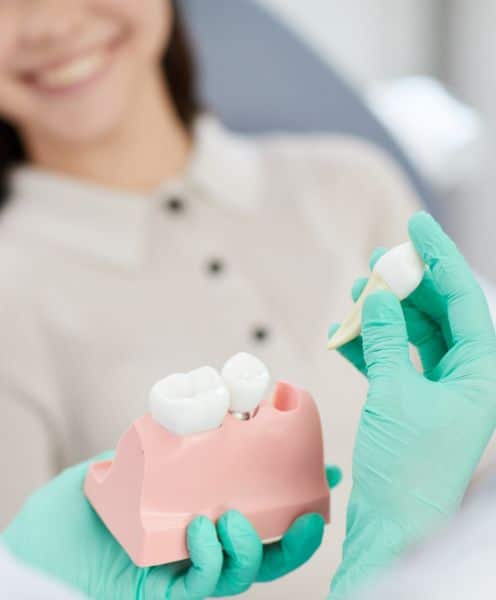
Getting A Tooth Extraction in Odessa, FL
CLICK TO CALLWHAT IS A TOOTH EXTRACTION PROCEDURE?
While the thought of having a tooth pulled can be scary and nerve-wracking, sometimes tooth extractions are the best course of treatment for your smile. A tooth extraction is when a dental surgeon removes a tooth and its roots from your mouth, by pulling it out of its socket in its entirety. The socket is the little space in which the tooth sits within your jawbone.
CLICK TO CALL
WHEN IS A TOOTH EXTRACTION RECOMMENDED?
There are a few reasons why a dentist would recommend a tooth extraction procedure:
- You have crowded teeth and your dentist needs to make more room for them. Or these crowded teeth are causing damage to the surrounding teeth.
- There has been severe damage done to the tooth/teeth (oral trauma).
- There is severe tooth decay/gum disease present.
- The wisdom teeth have become stuck below the surface of the gum line (impacted).
- There is an infection that is not responsive to medicine, that has taken over the tooth/teeth.
Tooth extractions are almost exclusively done on adult teeth, as baby teeth fall out on their own prior to the growth of permanent teeth. However, in the rare case that a baby tooth hasn’t fallen out on time, it may be extracted to make room for the adult tooth/teeth.

THE TOOTH EXTRACTION PROCESS: SIMPLE/SURGICAL OPTION
How a dentist goes about extracting a tooth is dependent on what state the tooth is in, and how complicated the extraction will be. There are two methods of extraction – simple and surgical.

SIMPLE TOOTH EXTRACTION
The first method is called a simple extraction, which is used for teeth that are visible and easily accessible. Most teeth can be removed with simple extractions, so long as they aren’t severely compromised by breakage or infection. The full procedure follows these steps:
- The dentist starts with a local anesthetic to numb the tooth and surrounding area. The tooth’s roots are full of nerves, so numbing them will drastically reduce pain.
- The patient’s mouth needs to be kept open, so a spacer, called an elevator, is used to accomplish this. It is possible to forego this step; however, it is generally better to include it to reduce fatigue and strain on the jaw.
- Extraction forceps are used to pull the tooth directly from the socket. Forceps like this are specially designed to get a grip on a tooth and to give the dentist plenty of leverage. This allows the dentist to remove it as gently as possible, and avoid damaging the surrounding area.
- After the tooth is extracted, the empty socket is cleaned thoroughly to remove any loose bone and tissue. The socket is compressed to reshape the jawbone, reduce and manage bleeding, and to close up the open space.

SURGICAL TOOTH EXTRACTION
The second method is known as a surgical extraction, and is employed when a tooth is in a critical condition, or difficult location. You may recognize this as the method used for wisdom teeth, but this also applies to teeth with extensive breakage, that are impacted, or just developed exceptionally long roots.
Every surgical extraction is different, depending greatly on the tooth, and the patient, and so it’s difficult to give an exact procedure. A much stronger anesthetic may be used, or you may be put to sleep all together. X-rays need to be taken to determine the exact state, location, and/or orientation of the tooth, as it could be growing in the wrong direction. An oral surgeon will often be called in to perform the surgery, although it is entirely possible for a general dentist to perform it as well, depending on their level of experience.

THE RISK OF GETTING A TOOTH PULLED OUT VIA EXTRACTION
As with any surgical procedure, tooth extractions do carry some relatively minor risks, including:
- Bleeding: After the tooth is pulled out, you should expect to bleed for a little while. This is completely normal, and you’ll be given gauze to bite down on to stop the bleeding. Extra gauze is given in case the bleeding doesn’t quite taper off as expected.
- Infections: It’s possible for an infection to develop at the extraction site. This is why it’s important to take care of the area, keep it clean, and follow the post-operative instructions. You may be given antibiotics to help prevent an infection from developing.
- Dry Sockets: You can get what is known as a “dry socket” if the blood clot that forms in the empty socket after extraction is dislodged or if it does not form at all. There is an increased risk of developing dry sockets if you use a straw or smoke within 48-hours after an extraction. If a dry socket forms, this leaves the socket exposed and susceptible to infection. Dry sockets are painful and do require you to come back into the dentist’s office for an examination. You’ll be given a medicated dressing to help reduce inflammation and swelling and to treat the area with antibiotics, so an infection doesn’t form.
- Nerve Damage: In very rare cases, the nerve that runs through the jawbone can be damaged during a tooth extraction. This can cause numbness or tingling in the lips, chin, or tongue.
Overall, tooth extractions are a relatively safe and easy procedure. The risks are low and the majority of people who have teeth pulled out, experience no complications.

HEALING AFTER A TOOTH EXTRACTION: RECOVERY TIME & EXPECTATIONS
Post tooth extraction recovery can take up to 6 months in total; however, you should be able to function normally following the first week after the procedure. Expect the following:
- Any initial bleeding should stop after 24 hours, but minor bleeding can occur after the first few days depending on the severity of the extraction.
- After the first week, you shouldn’t experience any bleeding, and only notice minor swelling and pain.
- Finally, over the next 4 weeks to 6 months, the underlying bone and tissues will heal completely, but you shouldn’t notice or feel a thing during this recovery period.
It is important that during the healing process, you follow the specific instructions set out for you, including rinsing your mouth out with salt water to reduce swelling, eating soft foods, applying a cold compress to the outside of your mouth, and avoiding using straws or smoking. If you follow these instructions and take care of the extraction site, you should be well on your way to a full recovery in no time!

NEED A TOOTH EXTRACTION?
Tooth extractions are a common and safe dental procedure, with a low risk of complication and a short recovery period. If you have any questions or concerns, be sure to reach out to us here at Spring Haven Dental by contacting us here. We will be more than happy to help you through the process!


